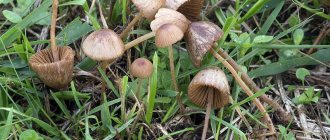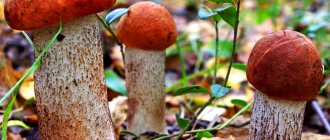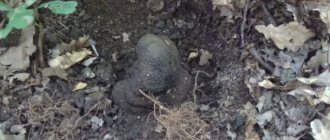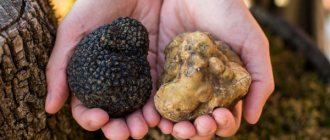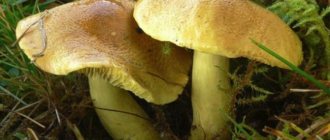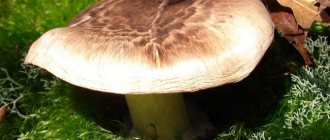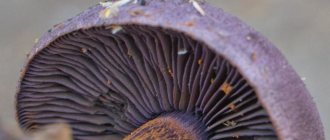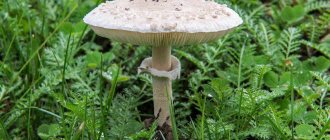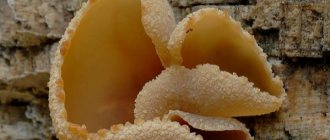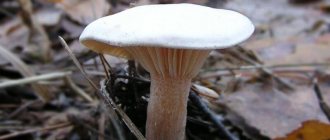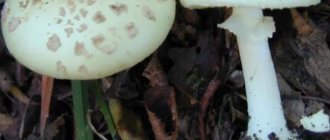Umbrella mushrooms and their poisonous counterparts: how to distinguish? Tips with photos
Umbrella mushrooms have only recently begun to be collected en masse in our latitudes. Previously, this delicacy was known only to a narrow circle of mushroom pickers. Everyone else considered umbrellas to be huge fly agarics or even toadstools. And now, thanks to the Internet, mushroom pickers have rushed to collect umbrellas and make delicious chops from them.
But how can you learn to distinguish and collect umbrellas and not confuse them with their poisonous counterparts? Let's find out!
Habitat and growing conditions
Experienced mushroom pickers know where the umbrella mushroom grows. It is one of the most widespread on the planet, therefore it grows on absolutely all continents, with the exception of Antarctica.
However, the growing conditions must be suitable:
- predominantly sandy soils;
- light forests;
- temperate climate;
- grassy places.
In different regions you can find the umbrella mushroom in various botanical atlases. Its main habitat is the northern temperate zone. In the European part, such mushrooms are found almost everywhere.
Various sources about umbrella mushrooms say that they appear in clearings next to light forests, edges and clearings. They prefer open areas covered with thick grass. In this regard, you can often find “umbrellas” of various sizes in park areas, fields and even in private gardens. The active growth season begins in June and continues until November.
WHICH FAMILY OF MUSHROOMS DOES THE UMBRELLA MUSHROOM BELONG TO?
The umbrella mushroom (the one that is the largest and which is difficult to confuse with something else) is called the variegated umbrella (lat. Macrolepiota procera) and belongs to the champignon family and can be eaten raw, without heat treatment (like the classic champignon).
Variegated umbrella mushrooms (lat. Macrolepiota procera). These are the ones you need to collect!
However, several other types of mushrooms are popularly called umbrellas - some lepiots (scaly umbrella) and chlorophyllum (reddened umbrella, lead-slag chlorophyllum, brown umbrella mushroom). All these species also belong to the champignon family, but some of them are poisonous!
WHAT UMBRELLAS DO I RECOMMEND COLLECTING?
Personally, I don't take any other umbrellas except the pied umbrella ( macrolepiota procera ).
✔ At the same time, you can only eat fresh, elastic mushrooms with light, not dried plates. Leave rotten, lethargic, sun-dried, too old or too young specimens in the forest! By the way, you can determine the freshness of an umbrella by its smell - a fresh one will have a mushroom or champignon scent, while a dried out one or one that is starting to deteriorate will acquire a slightly fishy smell, like a ram. These umbrellas are not worth taking.
❗ Do not take umbrellas with dark plates under the hat. At best, this will be a mushroom that has already begun to deteriorate; at worst, it will be a sign of the poisonous twin of the umbrella, which you will read about below.
✔ Place the umbrellas in a separate basket or on top of other mushrooms, as they will easily crumble and wrinkle if you put something else on top of them.
❗ Do not take young, unopened specimens and suspiciously small-sized opened umbrellas - they can be easily confused with poisonous double mushrooms of the variegated umbrella.
The umbrella is variegated in different stages of growth.
Cooking instructions
Wipe off the dark plates from the top of the caps with a wet sponge.
Immerse the caps, cut into sectors, in boiling water for a couple of minutes.
Strain them through a colander. Then the process of preparing the chops begins.
Dilute the eggs with water.
Whisk the batter. Add salt.
Salt the umbrella as well, and then dip each section of it in the batter.
Place the pieces into the heated oil.
When the bottom is browned, brown the other side as well.
Place the finished mushroom chops on a plate. Their juicy, sweetish-meaty taste and golden-brown batter just begs to be put under a knife and fork! With a neutral side dish of mashed potatoes, these mushroom relatives are simply amazing!
IS IT POSSIBLE TO COLLECT AND EAT THE RUBBING UMBRELLA (Chlorophyllum rhacodes)?
Mushroom pickers collect them, but I don’t take them, as they can easily be confused with lepiots or brown umbrella . And their unpleasant reddish tint at the place of cut or damage does not inspire confidence or desire to eat them. For the same reason, I don’t take maremukha (edible gray-pink fly agarics). And according to reviews from those who have eaten blushing umbrellas, they may cause allergic reactions and symptoms of mild poisoning. Therefore, for allergy sufferers and people with weak stomachs, I do not recommend collecting and eating umbrellas, the flesh of which turns red when damaged (cut or pressed).
WHAT CAN AN EDIBLE UMBRELLA MUSHROOM BE CONFUSED WITH (poisonous umbrellas and edible doubles of the variegated umbrella)
The variegated umbrella can be confused with: the brown umbrella (Chlorophyllum brunneum), other rare species of edible umbrellas, some types of lepiots and lead slag chlorophyllum (lat. Chlorophyllum molybdites). Let's consider all these types separately and highlight the differences.
✘ Lead-slag umbrella (Chlorophyllum molybdites)
The differences here are very subtle. Chlorophyllum lead slag is a poisonous mushroom, very similar to an umbrella. The cap is white, covered with pinkish-brown scales, from 7 to 30 centimeters in diameter, initially spherical, becoming almost flat with age. The stalk of the poisonous mushroom is smooth, 10-25 cm in height, from 1 to 3 cm in diameter, turns brown in places of damage, and has a ring in the upper part. The pulp is white, sometimes becomes reddish when cut, and has no pronounced taste or smell. The stem-free plates are white, changing color to grayish-green or olive with age. When pressed, the plates turn yellow or brownish. The false umbrella mushroom grows in the United States, Australia, Africa, and Eurasian countries.
That is, it differs from the edible variegated umbrella only in the pattern on the cap and, most importantly, in the color of the plates ! Moreover, in young specimens the plates may be white! The leaden tint appears in the mushroom only with age. It is found singly, in small groups or in “witch rings”, in gardens, meadows, and fields.
True, there is one big plus - Chlorophyllum lead-slag grows in North America, Australia and some countries of Eurasia. In Ukraine, this poisonous umbrella has not yet been officially recorded. But it’s all a matter of time, so be careful and always look under the cap!
✘ Umbrella (chlorophyllum) dark brown (Chlorophyllum brunneum)
Chlorophyllum is dark brown or brown - according to some sources, a poisonous mushroom, very similar to an umbrella mushroom. A mushroom with a fleshy scaly cap of brown color, reaching a diameter of 9-15 cm. The stem is white, becomes gray-brown with age, cylindrical in shape, thick and rather short. At the base of the leg there is a peculiar tuberous growth up to 6 cm in diameter. The flesh of the mushroom is white; when broken, it turns slightly reddish or orange. According to some information, the mushroom has a hallucinogenic effect, its toxic properties have not been fully studied, and eating it has led to allergic and other reactions in some people. These false umbrella mushrooms grow in the USA, Hungary, Czech Republic and Slovakia. This means they can meet here too.
❗ Chlorophyllum dark brown or brown is distinguished by its “stockiness” and short stature (lower and thicker leg) compared to the variegated umbrella, as well as the darker color of the scales on the cap and the fact that its flesh changes color when cut , like a blushing umbrella . The leg does not have the variegated pattern characteristic of an umbrella; it is smoother.
C chlorophyllum brunneum – false umbrella
Chlorophyllum brunneum - inedible umbrella! Its pulp changes color when cut!
❗ IN UKRAINE THERE IS AN UMBRELLA WITH DARK PLATES: ❗
If you see brown plates, you shouldn’t take such an umbrella!
Brown plates near a poisonous umbrella
The legs of the variegated and poisonous umbrellas are also different. The green arrow indicates the variegated umbrella, the red arrow indicates the legs of poisonous umbrellas.
Legs of edible and poisonous umbrellas - difference
✘ Scaly umbrella (Lepiota brunneoincarnata, Lepiota scaly, Lepiota brown-red)
❗❗ This is one of the most dangerous deadly poisonous mushrooms ❗❗
The cap of this poisonous lepiota is 2-7 cm in diameter, thin-fleshy, bell-shaped, semicircular, later flat or convexly spread, with a tubercle, creamy or grayish brown with a cherry tint, with dark scales arranged in concentric circles, which are often in the center merge and form a continuous cover of blackish cherry color, with a thin, tucked, later spread, wavy edge.
The mushroom stalk is about 2-4 X 0.5-0.8 cm, centrally located, cylindrical, sometimes slightly curved at the base, fistulous, white above the ring, below the ring, mainly at the base, dark cherry color with a flaky coating, with quickly disappearing ring.
It grows in beech forests, parks, gardens and cultivated soils. Considered a rare species. However, if you see such a mushroom, do not touch it with your hands!
✘ Lepiota acute scales
The mushroom is also known as rough umbrella, sharp-scaled umbrella and rough lepiota. See how to distinguish it from an edible umbrella
Description
Chestnut umbrella is a poisonous relative of champignons.
hat
It has a size of up to 4 cm, the shape varies from ovoid (at a young age) to convex and prostrate (with a central tubercle) at maturity; overripe mushrooms have an almost flat cap shape. The color is white with chestnut scaly outgrowths, merging centrally into a solid color.
Leg
In the form of a slightly expanded cylinder at the bottom, it measures 5*0.5 cm. It contains a cavity inside. Has the same color as the cap. In the upper third there is a ring-shaped remnant of velum, above which the surface is smooth and white, and above it is covered with scaly outgrowths of a brownish color. The base is pubescent. The ring, as a rule, is present only in young specimens (in mature specimens it is reduced).
Spore-bearing layer
The hymenophore is represented by white thin plates, located often and notched in relation to the stalk. With age, the plates turn yellow.
DIFFERENCES UMBRELLA FROM LEPIOT (BRIEFLY)
✤ The edible umbrella is really geometrically similar to an umbrella - with a thin leg relative to the size of the cap. Lepiots are either more “stocky”, “down to earth” and more “fleshy”, or completely microscopic in size (compared to an umbrella)!
✤ The variegated edible umbrella usually grows in large sizes - the cap is 20-35 cm in diameter and the leg is 10-30 (up to 40) cm high. Lepiots never grow this size!
✤ An edible umbrella always has a large ring on its leg that moves easily.
✤ During drought or after frost, you can see small edible umbrellas. I don’t recommend taking them, since it’s the easiest thing for a novice mushroom picker to remember: size matters!
✘ Fly agarics
Many beginners confuse edible umbrellas with fly agarics or other toadstools. However, once you see a real umbrella at least once, you will never confuse it with a fly agaric again!
Fly agarics do not have a ring (but have a “skirt”) and are more squat in shape and have a thicker leg. And the pattern on the hat is significantly different.
Edible fly agarics (maremukhi)
♠ RESULT: What umbrellas can I take? ♠
✔ We take only opened umbrellas of large sizes, on a thin stem (relative to the size of the hat), with elastic light flesh that does not change color when cut!
✔ The ring on the leg, if you move it, should move freely.
✔ The “pattern” on the umbrella leg should be easy to clean off with a fingernail.
❗ Unopened, dwarf-sized, blushing, yellowing, smelling of fish, having a strange unusual shape and an unusual pattern on the hat - we take a photo as a souvenir and leave it in the forest!
Signs of an edible umbrella in the photo:
The main characteristics of the edible variegated umbrella
= FACTS ABOUT UMBRELLAS, TO END =
The umbrella ring can be easily removed from the leg!
The plates are white or light cream in color (not gray, not brown or olive!)
In the variegated umbrella, the plates under the cap do not change color when pressed, but in the red umbrella they turn red. I do not recommend collecting a blushing umbrella!
Similar species
- The variegated umbrella mushroom ( Macrolepiota procera
) is larger, its flesh does not change color. - Thin umbrella mushroom ( Macrolepiota gracilenta
) and similar species are smaller in size and have a more slender stalk; their flesh does not turn red. - The maiden umbrella mushroom ( Leucoagaricus nympharum
) is distinguished by a very light cap and slightly changing flesh when cut.
Chlorophyllum brunneum
- Chlorophyllum molybdites
is found primarily in North America and is distinguished by its olive green spore print. - Chlorophyllum brunneum
is distinguished by its brown color, larger scales on the cap and a thick stalk with a powerful tuberous base, and is found in some European countries and North America.
Inedible doubles: poisonous umbrella mushrooms
The mushroom got its name due to its strong external resemblance to an umbrella. At first, the cap on the stem looks like a closed umbrella or dome, but soon it opens up and becomes a copy of the umbrella. It is important to remember that almost all edible mushrooms have false or poisonous counterparts. Umbrellas are also no exception and have their own inedible “brothers”. And therefore, mushroom pickers need to adhere to certain rules: do not collect mushrooms that are in doubt.
It is quite possible to distinguish an edible mushroom from a poisonous umbrella. And if, when you come to the forest, you do not know how and where to collect umbrellas, then you do not need to knock them down with your feet, mistaking them for poisonous mushrooms. Perhaps those who come after you will be glad of such a harvest.
We suggest that you familiarize yourself with the description and photo of poisonous umbrella mushrooms. There are 4 types of them in our region: combed umbrella, chestnut umbrella, brown-red and fleshy-red umbrella. However, only the first two types are considered the most dangerous.
Poisonous mushroom comb umbrella
Latin name of the comb umbel: Lepiota cristata;
Family: champignonaceae;
Cap: diameter from 2 to 5 cm, similar to a bell in juveniles and spread out in adults. The color is red-brown, with pointed yellow-orange scales on the surface.
Leg: very thin, empty in the middle, height from 7 to 10 cm, 0.5 cm in diameter, cylindrical, with a widening base. Color ranges from yellowish to cream, with a white or pink ring. The ring is quite narrow and disappears almost immediately.
Pulp: white pulp with fibrous inclusions, with a strong unpleasant odor.
Edibility: poisonous, completely unsuitable for food;
Distribution: prefers the northern regions of the country with a temperate climate.
How to distinguish an umbrella from a similar poisonous lepiota mushroom
Another poisonous mushroom that looks like an umbrella is the chestnut lepiota.
Latin name: Lepiota castanea;
Family: champignonaceae;
Cap: diameter from 2 to 4 cm, red or brown. The cap is ovoid only in young mushrooms; in adult specimens it is spread out. Next, the skin on the cap begins to crack into small hard scales of chestnut color. The plates under the cap become yellow over time;
Pulp: has a reddish or brown tint, especially when broken or cut, has an unpleasant odor and is very fragile when touched;
Leg: has a cylindrical shape that expands and descends towards the base. The ring on the leg is white, but quickly disappears with age;
Edibility: the mushroom is very poisonous, and when eaten it is most often fatal;
Distribution: grows in regions with temperate climatic conditions. It can often be found in Eastern and Western Siberia, as well as in European countries.
It is worth saying that the doubles of umbrella mushrooms are poisonous and very dangerous. Therefore, if you do not know exactly what kind of mushroom is in front of you, do not touch it.
How to distinguish the umbrella mushroom from lepiota - a poisonous mushroom? The leg of the poisonous lepiota is up to 12 cm in height, with a thickness of up to 1.2 cm. It is shaped like a cylinder, hollow inside, slightly curved, smooth, white. After the ring on the stem, the color changes and becomes yellowish or brown. If you touch the leg, it turns brown. Look at the photo on how to distinguish the umbrella mushroom from its poisonous counterpart:
How to distinguish an edible umbrella mushroom from a poisonous toadstool and fly agaric (with video)
To know the difference between edible and poisonous umbrella mushrooms, also watch the video. It will help you more accurately identify existing differences.
For example, how to distinguish an umbrella mushroom from a fly agaric? The fly agaric has scales on its cap, but they are rare. Usually the caps of this mushroom are almost smooth, with a small number of white scales. The umbrella is gray or brown with large white or gray scales. The umbrella leg is framed by three layers of white ring that slides down easily.
Many mushroom pickers confuse umbrellas with white toadstools and get poisoned. Therefore, the question arises: how to distinguish an umbrella mushroom from a toadstool?
Toadstool is a very toxic mushroom, and if accidentally consumed, death occurs in 90% of cases. The entire mushroom has a grayish or off-white tint. Its cap does not have scales, but is covered with flakes. The flesh of the white toadstool has a rather unpleasant chlorine odor. There is no ring on the stem; it disappears very early, leaving fragments of fiber instead.
How to distinguish an edible umbrella from an inedible purple mushroom
There is another false umbrella that can also be confused. How to distinguish the edible umbrella mushroom from the inedible one - the purple umbrella? The inedible purple mushroom has a corresponding color, bitter taste and unpleasant odor. Although this fruiting body is not poisonous, it is not recommended to eat it due to its strong bitterness. We invite you to look at a visual photo of the inedible umbrella mushroom:
It is worth noting that umbrella mushrooms are very common among representatives of the mushroom kingdom. Since they grow on decaying organic debris, on rotting plants, they are also called saprophytes. Sometimes umbrellas can reach very large sizes, for example, the cap in diameter can be more than 23 cm, and the height of the stem can be up to 30 cm. Umbrella mushrooms grow in circles, forming rings, popularly called “witch circles.” In such circles, umbrellas can grow to several dozen.
Red umbrella mushroom: poisonous or edible?
Some mushroom pickers are sure that the red umbrella mushroom is considered poisonous and therefore do not collect it. We hasten to reassure them, this mushroom is edible and very tasty.
Latin name: Macrolepiota rhacodes;
Family: champignonaceae;
Cap: beige or gray with fibrous-looking scales. Young mushrooms resemble a small chicken egg, and then their cap straightens out and resembles a bell. With age, it becomes completely flat with slightly rolled up edges;
Leg: smooth, white or light brown. The shape is cylindrical, tapering at the top and easily separated from the cap;
Plates: white or cream color, turn red when pressed;
Pulp: white, very brittle, fibrous. When cut it turns reddish-brown and has a pleasant smell;
Edibility: edible mushroom;
Distribution: deciduous and coniferous forests, acacia thickets. In addition to Russia, it can be found in Europe, Asia, Africa, Australia, and America.
Scientists warn that the red umbrella mushroom, even though it is edible, can cause severe allergic reactions in allergy sufferers.
Inedible white umbrella: what a poisonous mushroom looks like
Another umbrella that mushroom pickers consider inedible is the white umbrella mushroom.
How to cook
Cooking umbrella mushrooms is easy and quick, because you can even eat them raw in salads or on sandwiches. They are fried, stewed, soups are made with them, salted, pickled and dried.
Umbrella mushrooms in batter
Dish ingredients:
- Mushrooms - 500 grams;
- Flour - 2 tablespoons;
- Egg - 3 pieces;
- Onion (medium) - 2 pieces;
- Cheese (hard varieties) - 200 grams;
- Vegetable oil - 5 tablespoons;
- Table vinegar - 1 tablespoon;
- Salt, black pepper.
Cooking method:
- Peel the onion, cut into thin half rings, pour in vinegar, sprinkle with salt and leave to marinate for half an hour.
- Peel the mushroom caps, wash and dry.
- Beat eggs with flour, salt and pepper.
- Cut large mushrooms into several pieces.
- Heat the oil in a large frying pan, dip each piece of mushroom in the batter and fry on both sides for several minutes.
- Place onions on mushrooms.
- Grate the cheese on a coarse grater, pour it into a frying pan over the onions with fried mushrooms, turn off the heat and keep them on the stove for about five minutes so that the cheese melts.
The umbrella mushroom is one of the most delicious representatives of the mushroom kingdom. It is considered one of the varieties of champignons, although it differs from them both in appearance and taste. It belongs to the group of saprophytes, that is, those that grow on decomposing organic debris. This mushroom is distributed throughout the world, and in our country there are five of its varieties.
Despite such features, many mushroom pickers do not take it. Maybe because the edible umbrella mushroom looks like a fly agaric? But knowledgeable mushroom pickers are happy to collect young umbrellas, which grow in one place every year. Those who want to try the pleasant nutty taste of this mushroom need to know how to distinguish it from poisonous ones, where it grows and how to cook it correctly.
Features of the umbrella mushroom, edible and poisonous
Fans of mushroom hunting often come across such a find as an umbrella mushroom in the forest. Many mushroom pickers collect it in their basket, while others avoid it, considering it poisonous and extremely dangerous. This attitude is not accidental, because this “chameleon” has many doubles, and the ability to distinguish an edible specimen from an inedible one is vitally important.
What it looks like and where it grows
The umbrella mushroom is found on almost all continents, with the exception of Antarctica. It is difficult not to notice, as its shape and size immediately catch the eye. Usually this lover of light forests and open meadows grows to a respectable size. When fully opened, its hat resembles an open umbrella, rising on a long white stem. This mushroom just begs to be picked up and children especially often show interest in it, sometimes confusing edible and inedible varieties.
Given this,
it is very important that mushroom hunting takes place under the supervision of experienced adults .
But this mushroom is insidious in that it can be found not only in the forest, but also in any open clearings, even in garden plots. If such an umbrella mushroom has grown right in the garden, the main thing is to correctly determine whether it is an edible specimen or a toadstool. The edible mushroom has many subspecies, but toadstools also have a whole army of similar false varieties. Edible umbrellas are a type of champignon and have a pleasant taste and aroma. But this, of course, does not mean that they should be eaten raw. The Latin name for the mushroom is macrolepiote, which is formed from two words: “macro” (meaning “large”) and “Lepiota” (denoting a genus of mushrooms). It is no coincidence that the word “macro” appeared in the name; the edible umbrella mushroom is, as a rule, of impressive size. It can grow to a height of 40 cm with a cap diameter of up to 35 cm.
It is interesting that the cap does not immediately take on the appearance of an umbrella; at first it has a spherical shape and opens only over time.
Is an umbrella poisonous or not?
It all depends on whether the right type of mushroom ends up in the basket of a lover of “quiet hunting”. A general rule that helps distinguish a toadstool from an edible variety is this: a true umbrella mushroom, or parasol, is usually large in size.
Frail little umbrellas on thin stems are most often toadstools. But still, in order not to make a mistake in choosing, it is better to get acquainted with the appearance of umbrellas in more detail.
Edible species
Edible varieties are somewhat similar to each other, but at the same time they have some differences. Each species has its own, sometimes quite elegant and unexpected name.
- Graceful (or subtle) . Distributed in most European countries, grows in light, open forests, often found in grass. It grows singly and in dense groups; it is most often collected in late summer - early autumn. It reaches a height of 10−15 cm, the diameter of the cap is up to 15 cm. The cap has the shape of a cone; in its mature state it opens and becomes almost flat. The stem is thin, often curved, thickened at the base, with a “skirt” closer to the cap.
- Field (white). A lover of steppes and open mixed forests, it is found in meadows, pastures and pastures. They are collected throughout the summer, until mid-autumn. The cap is thick, fleshy, initially ovoid in shape, then cone-shaped. The surface of the cap is scaly, with a dark tubercle in the center, the color is whitish-beige, with uneven edges. Diameter - up to 12 cm. The leg has a height of 6-10 cm, is whitish-yellow, has a “skirt”, and is hollow inside. This species can easily be confused with the stinking fly agaric, so inexperienced mushroom pickers need to be especially careful.
- Conrad. Often found in forests and parks, prefers grassy meadows. The cap is thin along the edge, fleshy and dense in the center, has a beige-white color, a rounded ovoid-bell-shaped shape. Beige scales are scattered throughout the cap. Its size is up to 10 cm. The leg at the bottom is thick, beige-brown, up to 10-15 cm high, and has a wide movable “skirt”.
- Motley (large, tall) . One of the largest varieties. It is found on the edges, in sandy forests, prefers open light areas, and does not shy away from gardens, parks, meadows and pastures. You can collect from June to November. This giant has a height of up to 40 cm, and the cap can reach a diameter of 30-35 cm. Young mushrooms have a spherical cap, which opens over time. The leg is brown-brown, with a “skirt”.
- Mastoid. Loves beech and oak forests. Found from early summer to mid-autumn. The hat has a diameter of up to 10-12 cm, it is beige-coffee in color, with edges curved upward. Scales are scattered throughout the cap, closer to the edge. The height of the leg does not exceed 16 cm. It is hollow, has a brownish color on the outside, thickened at the base, with a “skirt”.
- Maidenish . One of the most elegant varieties, although small in size. Grows in light pine and mixed forests. The cap is 7-10 cm in diameter, it is cone-shaped or ovoid, light in color, with many folding beige scales. If you separate the cap from the stem, then at the point of separation it will acquire a reddish color. The height of the leg is up to 16 cm, it is beige and has a “skirt”.
- Blushing (shaggy). Loves fertile soils and open spaces. The cap can be quite large, from 10 to 20 cm in diameter. When cut, it acquires a red-brown color, and when pressed it turns orange. The leg is up to 15 cm high, thickened at the base, light or brownish in color. Grayish scales are scattered sloppily across the cap. The leg has a movable “skirt”.
Lepiots are poisonous mushrooms
Lepiots are inedible mushrooms of the champignon family.
Mostly found in coniferous and mixed forests, forest edges, clearings and pastures. Owners of household plots note the accumulation of poisonous lepiots in their gardens and vegetable gardens from mid-summer to the end of September. The lepiota mushroom grows both singly and in groups. Below you will find a description and photo of poisonous lepiota of various types: chestnut, rough and comb. You can also learn about mushroom counterparts and its uses.
Lepiota chestnut mushroom
Category: inedible.
The name of chestnut lepiota (Lepiota castanea) is translated from ancient Greek as “scales”.
Cap (diameter 2-6 cm): often cracked, in young mushrooms it is bell-shaped or ovoid, becoming more prostrate over time. It has a small bump in the center, the middle is usually darker than the edges. The light skin is densely dotted with chestnut or brown scales.
Leg (height 3-7 cm): cylindrical, tapering from bottom to top, usually hollow. Young mushrooms have a small ring.
The lepiota pulp is very brittle, under the skin of the cap it is light, almost white, and in the stem it is brown or dark red.
Plates: thin, usually white; in old mushrooms they can be yellow or light brown.
Doubles: none.
When it grows: from early July to mid-September in European countries and Siberia.
Where it can be found: on soils of deciduous and mixed forests.
Consumption as food: not consumed as it contains dangerous amatoxins.
Use in folk medicine: not used.
Other names: chestnut umbrella.
Poisonous mushroom lepiota rough
Category: inedible.
Cap of rough lepiota (Lepiota aspera) (diameter 5-15 cm): yellow, brownish or orange, dry to the touch. In young mushrooms, it is shaped like a small egg; over time it changes to a slightly convex shape. Small cracks or scales usually fall off in adult lepiots.
Salad “Firewood on the grass”
What ingredients are included in the snack with such an original name? Calm down: there is no wood or grass in the portioned salad recipe. Or rather, the first ones are rye crackers (store-bought, in the form of oblong sticks). And our grass will be finely chopped dill.
- Leave a handful of crackers for decoration. Mix the rest of the pack (100-150 grams) with mayonnaise.
- We do the same thing, only in separate containers, with 200 g of ham cut into thin strips, three hard-boiled and grated eggs, 3 pickles, half a can of green peas.
- Place the cylindrical frame on a flat plate. You can make it yourself by cutting off the top and bottom of a half-liter plastic bottle.
- Inside such a frame we lay out layers of: crackers, peas, ham, cucumbers, eggs.
- Sprinkle the top of the product with finely chopped dill.
- We remove the frame. We place 4-5 “logs” on the “grass” - croutons set aside for decoration.
Lepiota castanea
Current title
| Index Fungorum | Lepiota castanea Quél. |
| MycoBank | Lepiota castanea Quélet |
Systematic position
Etymology of the specific epithet
Castaneus, a, um chestnut. Also castanea, ae f 1) chestnut tree, chestnut; 2) chestnut (fruit).
Synonyms
- Lepiota ignicolor Bres., Fung. trident 2(8-10): 3 (1892)
- Lepiota rufidula Bres., Atti Imp. Regia Accad. Rovereto, ser. 3 8: 129 (1902)
- Lepiota ignipes Locq., Bull. trimest. Soc. mycol. Fr. 68:275 (1952)
Habit
- Fruiting body: Cap and stalk (agaricoid)
- Hymenophore: Lamellar (including folded or with vestigial plates)
hat
The cap is 15–40 mm in diameter, initially hemispherical, bell-shaped, then opens to a convex-spread, often with a wide tubercle. The surface is covered with concentrically located felt scales of dark red-brown, red-brown, orange-brown, the tissue between the scales is predominantly white. In the center the scales form a continuous coating, towards the edge they often disappear and are washed off [1].
The plates are loose, initially white, then beige, with age - with an orange tint, finely fringed along the edges [1].
Leg
Leg 22 – 65 mm long, 1 – 6 mm in diameter, cylindrical, often curved at the base, hollow in the upper part ¼ – ⅓ of the length, with an annular zone, above which it is light, pinkish-cream, without scales, below it is darker, red-brown, covered with scales of the same color as the scales on the cap [1].
Pulp
The flesh in the cap and the upper part of the leg is light, creamy, in the lower part of the leg it is reddish [1].
Microscopy
Spore powder is white [1].
Spores on the side 7.0 – 14.0 (15.5) × 3.0 – 5.5 µm, more or less cylindrical, with a spur-shaped process, thick-walled. Under the influence of Meltzer's reagent they turn yellow and brown (dextrinoid); stained in a Congo red solution; are not stained with cresyl blue [1].
Basidia 19 – 32 × 6 – 10 µm, 4-spore, rarely 2-spore [1].
Cheilocystids 19 – 41 × 5 – 10 µm, fusiform, narrow fusiform, narrow club-shaped, or cylindrical, colorless [1].
Pleurocystids are absent [1].
Pileipellis consists of cylindrical elements 55 – 330 × 7 – 22 µm, with or without septa (no more than 3 septa), with a dark, brown pigment. At the base of long elements, short club-shaped elements with brown thickened walls are rarely found [1].
Buckles are present in all fabrics [1].
Ecology and distribution
It grows singly and in groups in deciduous, coniferous and mixed forests, on litter [1][2].
Fruiting
The divisions correspond to the ten days of the month.
Nutritional properties
There is no exact information about the edibility of the species. Considering that many species of the genus Lepiota are poisonous and difficult to distinguish from each other, they should not be eaten.
Similar species
It is similar to other species of Lepiota.
Distribution throughout Western Siberia
Novosibirsk region: approx. Novosibirsk Academic Town [08/16/1970, 09/04/1986] (Perova N.V., Gorbunova N.A.), [August 2013, August 2015] (Ageev D.V.).
Tomsk region: Bakcharsky district, env. village Yarya [08/25/1969] (Perova N.V., Gorbunova N.A.).
Notes
- ↑ 12
According to Mycobank.org website - ↑ 1234
According to the Medicinal Mushrooms website - Vyacheslav Stepanov.
Lepiota acutesquamosa. Mushrooms of the Kaluga region. Retrieved June 21, 2011. Archived August 14, 2012. - Quélet, Lucien.
Enchiridion Fungorum in Europa media et praesertim in Gallia Vigentium. - Lutetiae: O. Doin, 1886. - 352 p. - ↑ 1 2 Kuo, M.
Lepiota acute squamosa. Retrieved July 12, 2011. Archived August 14, 2012. - Lepiota aspera (unavailable link - history
). Roger's Mushrooms. Retrieved July 12, 2011. Archived August 14, 2012. - Keller C, Maillard M, Keller J, Hostettmann K.
Screening of European fungi for antibacterial, antifungal, larvicidal, molluscidal, antioxidant and free-radical scavenging activities and subsequent isolation of bioactive compounds // Pharmaceutical Biology. - Taylor and Francis Ltd, 2002. - T. 40, No. 7. - P. 518-525.
